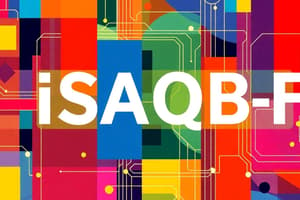Podcast
Questions and Answers
Which of the following scenarios represents the MOST effective application of architectural principles in software design?
Which of the following scenarios represents the MOST effective application of architectural principles in software design?
- A software team adopts a set of architectural principles and regularly re-evaluates these to ensure they align with project goals and evolving business needs. (correct)
- A software team adheres strictly to predefined architectural principles, even when those principles demonstrably hinder progress on a specific project.
- A software team allows individual developers to select their preferred architectural principles on a per-module basis, thereby maximizing individual autonomy.
- A software team disregards architectural principles in favor of rapidly prototyping new features, planning to address architectural concerns later.
In the context of software architecture, what is the primary difference between an architectural pattern and an architectural tactic?
In the context of software architecture, what is the primary difference between an architectural pattern and an architectural tactic?
- An architectural pattern focuses on security concerns, while an architectural tactic focuses on performance optimization.
- An architectural pattern is used in agile development, while an architectural tactic is used in waterfall development.
- An architectural pattern is documented using informal diagrams, while an architectural tactic requires formal mathematical proof.
- An architectural pattern addresses a recurring design problem with a proven solution, while an architectural tactic is a specific design decision influencing a single quality attribute. (correct)
How does the concept of 'ubiquitous language' in Domain-Driven Design (DDD) MOST directly contribute to the success of a software project's architecture?
How does the concept of 'ubiquitous language' in Domain-Driven Design (DDD) MOST directly contribute to the success of a software project's architecture?
- It enforces strict coding standards across the entire project, ensuring consistency and reducing technical debt.
- It automates the translation of business requirements into executable code, reducing the risk of misinterpretation.
- It ensures that all team members use the same technical jargon, improving code maintainability.
- It facilitates communication between domain experts and developers by establishing a common vocabulary, leading to a more accurate representation of the business domain in the software. (correct)
Which of the following approaches BEST exemplifies the management of technical debt within an Agile development environment focused on evolutionary architecture?
Which of the following approaches BEST exemplifies the management of technical debt within an Agile development environment focused on evolutionary architecture?
In the context of cloud architecture, what is the MOST critical consideration when designing for resilience in a distributed system?
In the context of cloud architecture, what is the MOST critical consideration when designing for resilience in a distributed system?
What is the MOST significant challenge in adopting a microservices architecture compared to a monolithic architecture?
What is the MOST significant challenge in adopting a microservices architecture compared to a monolithic architecture?
Which of the following statements BEST describes the trade-offs involved when prioritizing security as a quality attribute in software architecture?
Which of the following statements BEST describes the trade-offs involved when prioritizing security as a quality attribute in software architecture?
Which scenario BEST illustrates the application of the 'separation of concerns' architectural principle?
Which scenario BEST illustrates the application of the 'separation of concerns' architectural principle?
Which of the following is the MOST significant benefit of employing architecture documentation, such as the '4+1' view model, in a complex software project?
Which of the following is the MOST significant benefit of employing architecture documentation, such as the '4+1' view model, in a complex software project?
In the context of software architecture, which of the following actions is the MOST effective way to AVOID the 'Big Ball of Mud' anti-pattern?
In the context of software architecture, which of the following actions is the MOST effective way to AVOID the 'Big Ball of Mud' anti-pattern?
Flashcards
Software Architecture
Software Architecture
The fundamental organization of a software system, embodied in its components, their relationships, and guiding principles.
Architectural Patterns
Architectural Patterns
Reusable solutions to commonly occurring problems in software design, providing a high-level structure. Examples: layered architecture, microservices.
Architecture Documentation
Architecture Documentation
Captures the design decisions, rationale, and structure of a software system. Includes logical, development, process, and physical views.
Quality Attributes
Quality Attributes
Signup and view all the flashcards
Architectural Principles
Architectural Principles
Signup and view all the flashcards
Architectural Patterns
Architectural Patterns
Signup and view all the flashcards
Architectural Tactics
Architectural Tactics
Signup and view all the flashcards
Anti-Patterns
Anti-Patterns
Signup and view all the flashcards
Technical Debt
Technical Debt
Signup and view all the flashcards
Microservices
Microservices
Signup and view all the flashcards
Study Notes
- iSAQB Certified Professional for Software Architecture - Foundation Level (CPSA-F) certification focuses on fundamental knowledge of software architecture.
- It covers concepts, methods, and best practices for designing and documenting software architectures.
- The certification is aimed at software developers, architects, and anyone involved in software design.
Software Architecture Fundamentals
- Software architecture defines the fundamental organization of a software system, embodied in its components, their relationships to each other and to the environment, and the principles guiding its design and evolution.
- Key concerns include system structure, behavior, interaction, and non-functional requirements.
- Architecture enables communication among stakeholders, reduces complexity, and facilitates reuse.
Technical Context
- Understanding the technical context is crucial for designing effective architectures.
- This involves analyzing technical constraints, available technologies, and the development environment.
- Considerations include performance requirements, security constraints, scalability needs, and platform limitations.
Architectural Patterns and Styles
- Architectural patterns are reusable solutions to commonly occurring problems in software design.
- Examples include layered architecture, microservices, and event-driven architecture.
- Architectural styles define a family of systems, sharing a common vocabulary of components and connectors, with constraints on how they can be combined.
- Styles include object-oriented, client-server, and message-oriented architectures.
Architecture Documentation
- Architecture documentation captures the design decisions, rationale, and structure of a software system.
- It serves as a communication tool for stakeholders and a blueprint for development.
- Documentation should include views of the architecture, such as logical, development, process, and physical views.
- The "4+1" view model is a common approach to architecture documentation.
Architecture Communication
- Effective communication is essential for successful software architecture.
- Architects need to communicate with stakeholders, development teams, and other architects.
- Communication methods include diagrams, documents, presentations, and meetings.
- It is important to tailor the communication to the audience and purpose.
Architecture Evaluation
- Architecture evaluation assesses the quality and suitability of a software architecture.
- It helps identify potential risks and areas for improvement.
- Evaluation methods include scenario-based evaluation, architecture reviews, and attribute-driven design.
- Common quality attributes assessed include performance, security, reliability, and usability.
Quality Attributes
- Quality attributes, also known as non-functional requirements, define the desired characteristics of a software system.
- Examples include performance, security, reliability, usability, maintainability, and scalability.
- Quality attributes should be measurable and testable.
- Trade-offs between different quality attributes often need to be considered.
Architecture Design Process
- The architecture design process involves a series of activities aimed at creating a suitable architecture for a software system.
- Key activities include requirements analysis, architecture design, architecture evaluation, and implementation guidance.
- Iterative and incremental approaches are commonly used in architecture design.
- The process should be tailored to the specific project and context.
Scope of Architecture
- Defining the scope of the architecture is critical for managing complexity and focusing efforts.
- The scope should align with the system boundaries and key stakeholders.
- Considerations include the system's functionality, interfaces, and interactions with other systems.
Stakeholder Needs
- Understanding stakeholder needs is essential for designing successful architectures.
- Stakeholders include users, developers, operators, and business owners.
- Architects need to elicit and prioritize stakeholder requirements.
- Conflicting stakeholder needs may require trade-offs.
Principles
- Architectural principles are guiding statements that inform design decisions and promote consistency.
- Examples include separation of concerns, single responsibility, and open/closed principle.
- Principles should be aligned with the overall goals and values of the organization.
Patterns vs. Tactics
- Architectural patterns are proven solutions to recurring design problems, providing a high-level structure.
- Architectural tactics are specific design decisions that influence a single quality attribute.
- Tactics are more granular than patterns and can be combined to achieve desired quality attribute levels.
Anti-Patterns
- Anti-patterns are common solutions to recurring problems that are ineffective and may result in negative consequences.
- Recognizing and avoiding anti-patterns is important for designing robust and maintainable architectures.
- Examples include the "Big Ball of Mud" and "Golden Hammer" anti-patterns.
Technical Debt
- Technical debt represents the implied cost of rework caused by choosing an easy solution now instead of a better approach that would take longer.
- Accumulating excessive technical debt can negatively impact maintainability, performance, and security.
- Managing technical debt involves identifying, prioritizing, and addressing it proactively.
Agility and Architecture
- Agile development emphasizes iterative and incremental development, with a focus on responding to change.
- Architecture plays a critical role in enabling agility by providing a stable and flexible foundation.
- Evolutionary architecture allows the architecture to evolve over time, adapting to changing requirements and technologies.
- Architects in agile environments need to collaborate closely with development teams and stakeholders.
Microservices
- Microservices architecture structures an application as a collection of loosely coupled, independently deployable services.
- Each service is responsible for a specific business capability.
- Microservices enable scalability, flexibility, and faster development cycles.
- Challenges include increased complexity, distributed tracing, and managing inter-service communication.
Domain-Driven Design (DDD)
- Domain-Driven Design is an approach to software development that focuses on modeling the domain knowledge and aligning the software with the business domain.
- Key concepts include ubiquitous language, bounded contexts, and aggregates.
- DDD can inform architectural decisions and help create more maintainable and scalable systems.
Cloud Architecture
- Cloud architecture involves designing and deploying software applications and services in a cloud environment.
- Cloud environments offer scalability, elasticity, and cost-effectiveness.
- Considerations include choosing the right cloud platform, designing for resilience, and managing security.
Security Architecture
- Security architecture focuses on designing and implementing security controls to protect software systems and data.
- Key principles include defense in depth, least privilege, and secure coding practices.
- Security architects need to consider various threats and vulnerabilities, such as malware, hacking, and data breaches.
Performance Architecture
- Performance architecture focuses on designing and optimizing software systems to meet performance requirements.
- Key activities include performance modeling, load testing, and optimization techniques.
- Performance architects need to consider factors such as CPU utilization, memory usage, and network latency.
Maintainability
- Maintainability is the ease with which a software system can be modified, corrected, or adapted to meet new requirements.
- Architectural decisions can significantly impact maintainability.
- Modular design, loose coupling, and clear documentation are important for achieving high maintainability.
Evolution
- Software architectures need to evolve over time to adapt to changing requirements, technologies, and business needs.
- Evolutionary architecture supports incremental changes and minimizes disruption to existing systems.
- Architects need to plan for evolution and anticipate future changes.
Studying That Suits You
Use AI to generate personalized quizzes and flashcards to suit your learning preferences.





